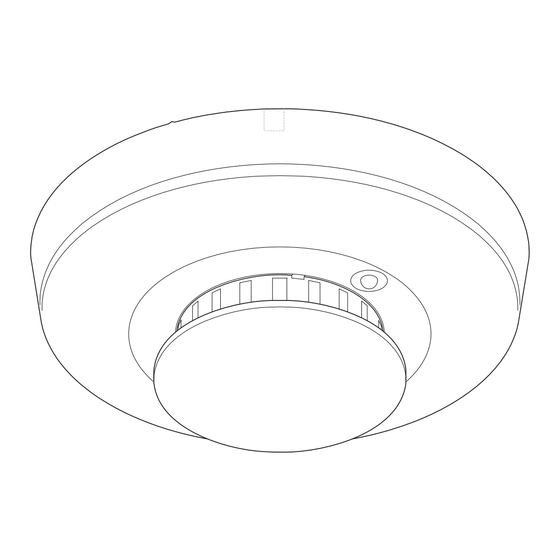
Advertisement
Table of Contents
- 1 Selecting a Location
- 2 Installing the Detector
- 3 Removing the Detector
- 4 Understanding the LED
- 5 Smoke Testing
- 6 Cleaning the Detector
- 7 Maintenance
- 8 Fire Prevention and Escape
- 9 Model Numbers
- 10 Product Ordering
- 11 Specifications
- 12 Regulatory Information
- 13 Contact Information
- Download this manual
ESL 500N Series Smoke Detector
Installation Sheet
Description
This document is intended for licensed electricians or
Note:
alarm installers. We cannot provide technical support to
unqualified persons. If you have any questions, contact us
using the "Contact information" on page 8.
The ESL 500N Series conventional two-wire and four-wire
photoelectric smoke detectors have intelligent software and
digitally processed sensing capabilities. This intelligence,
coupled with the ESL patented optical sensing chamber,
means the ESL 500N Series quickly and accurately detects
smoke. CleanMe compatible software, self-diagnostics, and
dust (drift) compensation are standard in every unit. The ESL
500N Series offers application flexibility with optional auxiliary
relays, rate-of-rise/fixed temperature heat sensors, isolated
heat sensors and/or 85 dBA temporal-three sounders.
Standard features
All models ship standard with the features described below.
Discourages unauthorized removal of the
Detector-base lock:
smoke detector by requiring a screwdriver to remove the
detector from the base.
Includes automatic sensitivity testing. Once
Self-diagnostics:
a day and immediately upon first power up, each 500N Series
detector performs a full diagnostic test that includes a dynamic
test of the sensing chamber and internal electronics. This
meets NFPA 72 field sensitivity testing requirements without
the need for external meters.
Drift compensation (dust compensation):
automatically adjust sensitivity, up to a maximum of 1.0%/ft.,
as the detectors become dirty.
© 2017 United Technologies Corporation
Additional features
Depending on the model, the smoke detector may also provide
the following features.
CleanMe:
receive a warning signal, indicating that the optical chamber
needs to be replaced. This feature is available on the 500N
Series two-wire detectors only.
The 500N Series two-wire detectors enable the CleanMe
function by recognizing voltage polarity at installation. If the +
and − terminal connections are reversed, the CleanMe function
is enabled. New 500N Series detectors are compatible on the
same loop with previous 500 Series detectors if proper wiring
is observed. See "Wiring" on page 4.
Integral temporal-three sounder:
sounder, a piezoelectric horn produces an interrupted 85 dBA
tone when the detector alarms or when the polarity is reversed.
Sounder follows input voltage in reverse polarity.
In order for all sounders to activate when the panel alarms, the
panel must reverse the supply voltage polarity to the loop on
alarm. If the panel does not implement polarity reversal, an
ESL 405 Polarity Reversal Relay Module must be used. (Refer
to the installation sheet for the ESL 405 Polarity Reversal
Relay Module.)
Auxiliary and end-of-line relays:
and operate at 1 A
auxiliary notification devices to the smoke loops. Products with
an "R" in the suffix signify the auxiliary relay feature.
An end-of-line relay operates as a power supervision relay and
is normally energized and will release with the loss of power.
Products with an "E" in the suffix signify the end-of-line feature.
Heat sensors:
temperature heat sensors which allow the unit to detect
changes in temperature that may signal a fire event. Models
with an "XT" in the suffix have a heat sensor included.
Some models are available with an isolated heat sensor. If the
unit senses a temperature change it will alert the panel and
signal an alarm independent of smoke in the photoelectric
chamber. The heat alarm output is on the alarm relay and the
smoke detector output is on the auxiliary relay. Models with an
"H" in the suffix have an isolated heat sensor which is both rate
of-rise and fixed temperature.
The detectors
1 / 8
Enables a CleanMe compatible control panel to
In the 500N models with
Auxiliary relays are Form C
30 VDC to allow for the addition of
at
Some models come with rate-of-rise or fixed
P/N 1036525-EN • REV F
Advertisement
Table of Contents

Summarization of Contents
Description
Standard features
Summarizes basic functionalities like detector-base lock, self-diagnostics, and drift compensation.
Additional features
Details optional features like CleanMe, sounders, auxiliary relays, and heat sensors.
Selecting a location
Additional considerations
Provides guidelines for optimizing placement and reducing false alarms.
Installing the detector
Removing the detector
Explains how to detach the detector from its mounting base.
Wiring
Figure 6: 500N Series two-wire wiring
Diagram for connecting two-wire detectors, noting polarity sensitivity and CleanMe.
Figure 7: 500N Series four-wire wiring
Diagram for four-wire detectors, noting they are not CleanMe compatible.
Figure 8: 500N series four-wire E model wiring
Diagram for four-wire E models, also not CleanMe compatible.
Sensitivity testing
Flashes Indication
Table correlating LED flashes to sensitivity status and required actions.
Fire prevention and escape
Avoid fire hazards
Lists safety precautions to prevent fires and protect occupants.
Model numbers
Figure 12: Model number codes
Explains the coding system for model numbers and their features.







Need help?
Do you have a question about the 521NCSXT and is the answer not in the manual?
Questions and answers